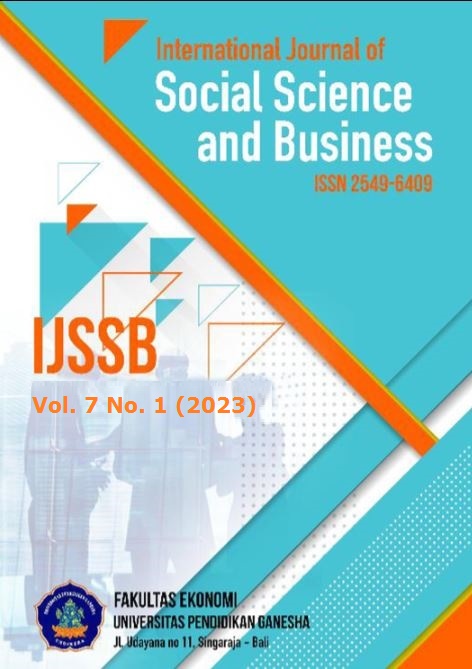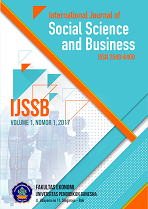Marketing Communications as Strategy Expanding Market Share In Era 4.0
DOI:
https://doi.org/10.23887/ijssb.v7i1.53535Keywords:
marketing communication, relationship contact, strategyAbstract
Today's markets and commercial connections span the globe. Meanwhile, the slow pace of economic growth and the resulting difficulties for businesses stimulate a drive toward greater efficiency and effectiveness. Since marketing efforts affect the present and future health of markets and businesses, they have evolved into an essential business component. Adapting to the ever-changing environment is one of the most important aspects of using them. This study identifies successful strategies in marketing communications that can be used to achieve success based on factors such as culture, lifestyle, purchasing habits, consumption patterns, preferred communication channels, and more. In this study, researchers used a qualitative technique, which involves gathering information via in-depth interviews, document analysis, and direct observation of the topic. In this context, marketing communication is crucial since it helps direct potential customers to the products they need based on their culture, lifestyle, purchasing habits, consumption patterns, preferred communication channels, and more. Promoting the product to address the market's requirements, desires, and expectations relies on marketing communication to disseminate information about the product. It might lead to the growth of new market segments. If a product's market share grows, so do its marketing successes.
References
Alhaddad, A. (2014). The effect of brand image and brand loyalty on brand equity. International Journal of Business and Management Invention, 3(5), 28–32.
Ardianto, E. (2016). HandBook of Public Relations; Pengantar Komprrehensif. Simbiosa Rekatma Media.
Batra, R., & Keller, K. L. (2016). Integrating marketing communications: New findings, new lessons, and new ideas. Journal of Marketing, 80(6), 122–145. https://doi.org/10.1509/jm.15.0419. DOI: https://doi.org/10.1509/jm.15.0419
Berthon, P. R., Pitt, L. F., Plangger, K., & Shapiro, D. (2012). Marketing meets Web 2.0, social media, and creative consumers: Implications for international marketing strategy. Business Horizons, 55(3), 261–271. https://doi.org/10.1016/j.bushor.2012.01.007. DOI: https://doi.org/10.1016/j.bushor.2012.01.007
Brown, D. M., & Thompson, A. (2022). Principles of Integrated Marketing Communications. In Essentials of Marketing (pp. 321–344). Cambridge University Press. https://doi.org/10.4324/9781003170891-17. DOI: https://doi.org/10.4324/9781003170891-17
Buil, I., de Chernatony, L., & Martínez, E. (2013). Examining the role of advertising and sales promotions in brand equity creation. Journal of Business Research, 66(1), 115–122. https://doi.org/10.1016/j.jbusres.2011.07.030. DOI: https://doi.org/10.1016/j.jbusres.2011.07.030
Darroch, J. (2014). Why marketing to women doesn’t work: Using market segmentation to understand consumer needs. In Why Marketing to Women Doesn’t Work: Using Market Segmentation to Understand Consumer Needs. Springer. https://doi.org/10.1057/9781137358172. DOI: https://doi.org/10.1057/9781137358172
Drugău-Constantin, A. (2018). Emotional and cognitive reactions to marketing stimuli: Mechanisms underlying judgments and decision making in behavioral and consumer neuroscience. Economics, Management, and Financial Markets, 13(4), 45–50. https://doi.org/10.22381/EMFM13420183. DOI: https://doi.org/10.22381/EMFM13420183
Fiantika, F. (2022). Metodologi Penelitian Kualitatif. In Metodologi Penelitian Kualitatif. In Rake Sarasin (Issue March, pp. 54–68). PT Remaja Rosdakarya. https://scholar.google.com/citations?user=O-B3eJYAAAAJ&hl=en.
Gallaugher, J., & Ransbotham, S. (2010). Social media and customer dialog management at Starbucks. MIS Quarterly Executive, 9(4), 197–212. https://aisel.aisnet.org/misqe/vol9/iss4/3/.
Gordon, R. (2013). Unlocking the potential of upstream social marketing. European Journal of Marketing, 47(9), 1525–1547. https://doi.org/10.1108/EJM-09-2011-0523. DOI: https://doi.org/10.1108/EJM-09-2011-0523
Hudson, S., & Thal, K. (2013). The Impact of Social Media on the Consumer Decision Process: Implications for Tourism Marketing. Journal of Travel and Tourism Marketing, 30(1–2), 156–160. https://doi.org/10.1080/10548408.2013.751276. DOI: https://doi.org/10.1080/10548408.2013.751276
Jahdi, K. S., & Acikdilli, G. (2009). Marketing Communications and Corporate Social Responsibility (CSR): Marriage of Convenience or Shotgun Wedding? Journal of Business Ethics, 88(1), 103–113. https://doi.org/10.1007/s10551-009-0113-1. DOI: https://doi.org/10.1007/s10551-009-0113-1
Kahn, K. B. (2018). Understanding innovation. Business Horizons, 61(3), 453–460. https://doi.org/10.1016/j.bushor.2018.01.011. DOI: https://doi.org/10.1016/j.bushor.2018.01.011
Keller, K. L. (2016). Unlocking the Power of Integrated Marketing Communications: How Integrated Is Your IMC Program? Journal of Advertising, 45(3), 286–301. https://doi.org/10.1080/00913367.2016.1204967. DOI: https://doi.org/10.1080/00913367.2016.1204967
Keller, K. L. (2020). Brand Equity and Integrated Communication. In Integrated Communication (pp. 113–142). Psychology Press. https://doi.org/10.4324/9780203773475-13. DOI: https://doi.org/10.4324/9780203773475-13
Kitchen, P. J., & Proctor, T. (2015). Marketing communications in a post-modern world. Journal of Business Strategy, 36(5), 34–42. https://doi.org/10.1108/JBS-06-2014-0070. DOI: https://doi.org/10.1108/JBS-06-2014-0070
Kotler. (2012). Manajemen Pemasaran Jilid 1, Edisi Kesebelas. In Jakarta. Erlangga.
Kotler, P., & Keller, K. L. (2016). A Framework for Marketing Management. In Marketing Management. Pearson Boston, MA.
Krizanova, A., Lazaroiu, G., Gajanova, L., Kliestikova, J., Nadanyiova, M., & Moravcikova, D. (2019). The effectiveness of marketing communication and importance of its evaluation in an online environment. Sustainability (Switzerland), 11(24). https://doi.org/10.3390/su11247016. DOI: https://doi.org/10.3390/su11247016
Kumar, V., Choi, J. W. B., & Greene, M. (2017). Synergistic effects of social media and traditional marketing on brand sales: capturing the time-varying effects. Journal of the Academy of Marketing Science, 45(2), 268–288. https://doi.org/10.1007/s11747-016-0484-7. DOI: https://doi.org/10.1007/s11747-016-0484-7
Lin, F., Ansell, J., Marshall, A., & Ojiako, U. (2019). Managing and building B2B SME brands: an emerging market perspective. PSU Research Review, 3(3), 191–214. https://doi.org/10.1108/prr-04-2019-0010. DOI: https://doi.org/10.1108/PRR-04-2019-0010
Oliva, R. A. (2022). A high-level overview: a value-based perspective on the practice of business-to-business (B2B) marketing. In Handbook of Business-to-Business Marketing. Edward Elgar Publishing. https://doi.org/10.4337/9781800376878.00010. DOI: https://doi.org/10.4337/9781800376878.00010
Perbawasari, S., Sjuchro, D. W., Setianti, Y., Nugraha, A. R., & Hafiar, H. (2019). Government Marketing Public Relations Strategy in Preparing Halal Tourism in Priangan Region. MIMBAR : Jurnal Sosial Dan Pembangunan, 35(1), 89–103. https://doi.org/10.29313/mimbar.v35i1.4134. DOI: https://doi.org/10.29313/mimbar.v35i1.4134
Popescu, I. C., Dumitru, I., Veghes, C., & Kailani, C. (2013). Marketing Communication As a Vector of the Romanian Small Businesses Sustainable Development. Amfiteatru Economic, 15(7), 671–686. https://www.amfiteatrueconomic.ro/temp/Article_1233.pdf.
Ramadani, F., & Sofia, K. R. (2019). Marketing Public Relations Strategy to Build Image of Innisfree through the Use of Virtual Reality. Jurnal Penelitian Komunikasi, 22(2). http://mail.bppkibandung.id/index.php/jpk/article/viewFile/635/389. DOI: https://doi.org/10.20422/jpk.v22i2.635
Ruslan, R. (2017). Manajemen Public Relations and Media Komunikasi Dalam Donni Juni Priansa Komunikasi Pemasaran Terpadu. Pustaka Setia.
Šerić, M., Gil-Saura, I., & Ruiz-Molina, M. E. (2014). How can integrated marketing communications and advanced technology influence the creation of customer-based brand equity? Evidence from the hospitality industry. International Journal of Hospitality Management, 39, 144–156. https://doi.org/10.1016/j.ijhm.2014.02.008. DOI: https://doi.org/10.1016/j.ijhm.2014.02.008
Silva, M. B. (2016). Percepção da população assistida sobre a inserção de estudantes de medicina na Unidade Básica de Saúde. In Trabalho de conclusão de curso (Vol. 1, Issue 9). Simon and Schuster. https://doi.org/10.1017/CBO9781107415324.004. DOI: https://doi.org/10.1017/CBO9781107415324.004
Tairova, M. M., & Giyazova, N. B. (2020). Goal and Objectives of Integrated Marketing Communications. In Economics (Vol. 3, Issue 2 (45), pp. 5–7). ООО «Олимп». https://cyberleninka.ru/article/n/goal-and-objectives-of-integrated-marketing-communications.
Widuhung, S. M. (2021). Strategi Marketing Public Relations Petromindo Group Di era Pandemi Covid-19. Jurnal Public Relations, 2(1), 1–7. http://jurnal.bsi.ac.id/index.php/jpr/article/view/308/124.
Downloads
Published
How to Cite
Issue
Section
License
Copyright (c) 2022 Abdul Haris, Hasrat Effendi Samosir, Siti Hawa Lubis

This work is licensed under a Creative Commons Attribution-ShareAlike 4.0 International License.











